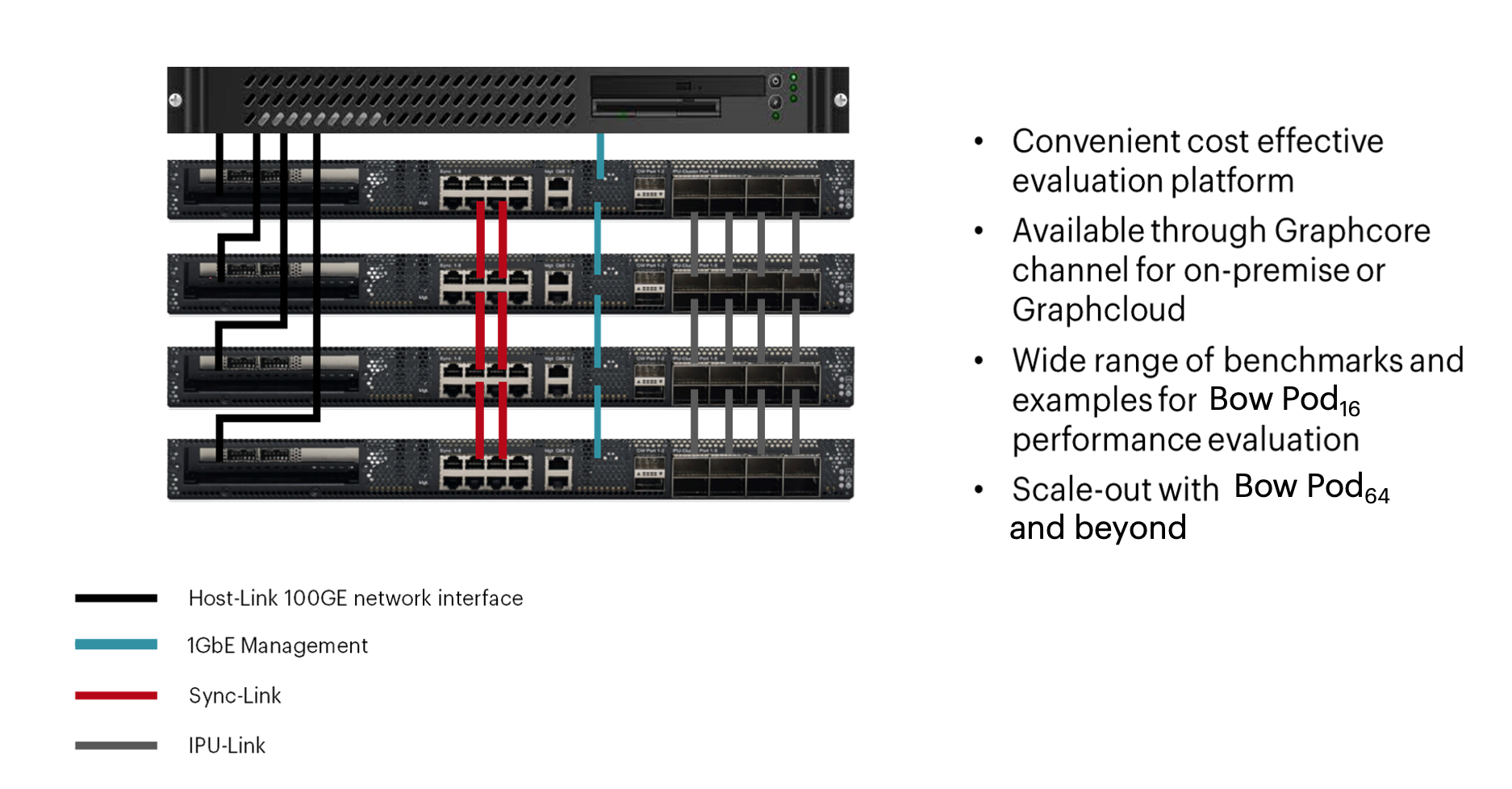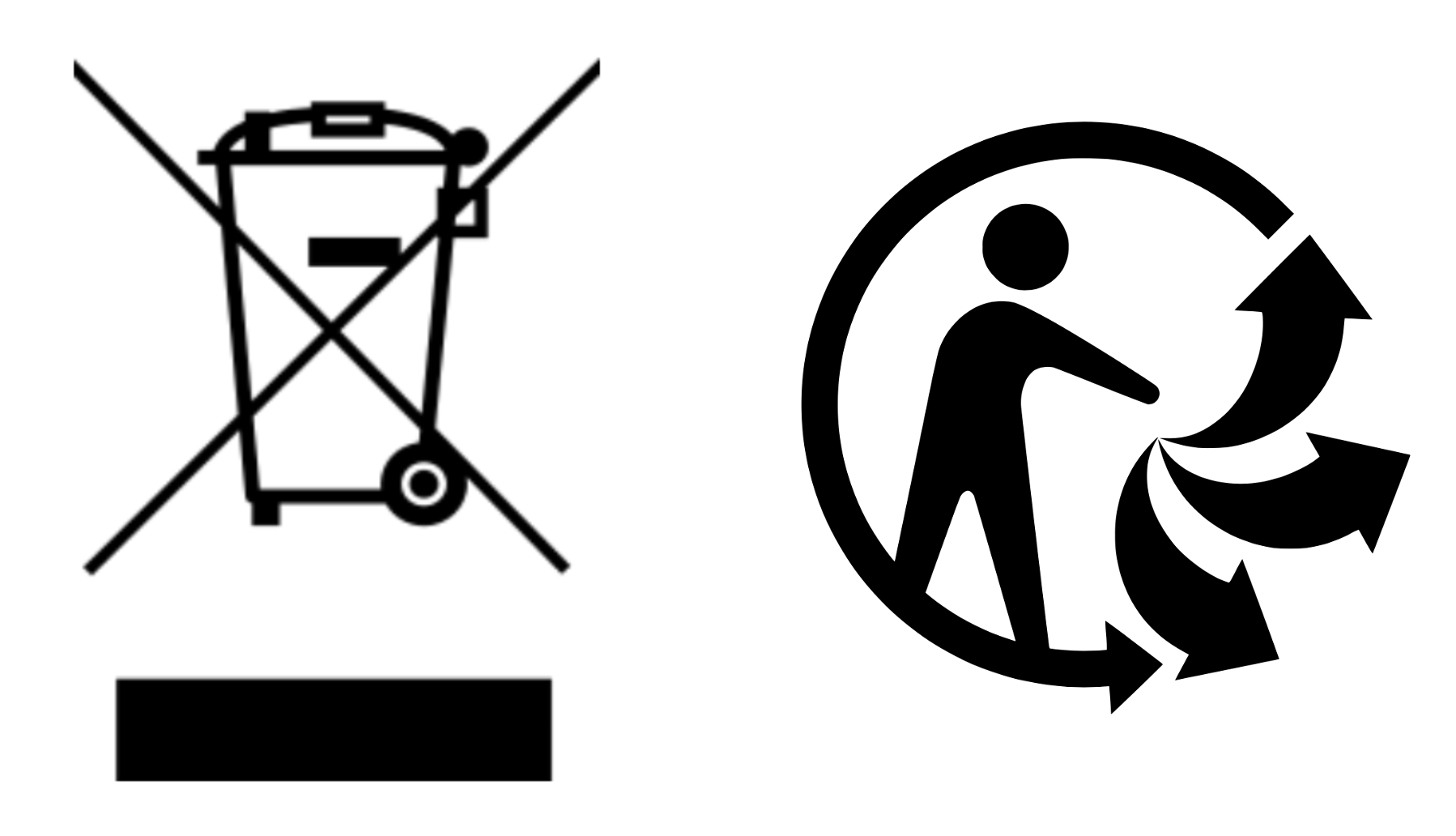2. Product description
2.1. Bow Pod16 Direct Attach
Graphcore’s Bow Pod16 Direct Attach system combines four Bow-2000 IPU-Machines delivering 5.6 petaFLOPS of AI compute. The Bow-2000s are directly attached to a pre-qualified host server - see the approved servers list for details of servers approved for use with the Bow Pod16.
The Bow Pod16 is a compact and powerful platform ideal for exploration, experimentation and concept and pilot development and is designed to scale with additional Bow-2000 IPU-Machines, host servers and a top of rack switch to a full Bow Pod64. Bow Pod64 logial racks can be used individually (64 Bow IPU processors) or as a building block for larger systems such as the Bow Pod256 (256 Bow IPUs), going up to 1024 Bow Pod64 racks (64K Bow IPU processors) delivering nearly 23 exaFLOPS of AI compute.
A high-level view of the Bow Pod16 cabling is shown in Fig. 2.1.

Fig. 2.1 Bow Pod16 cabling
2.2. Software
Bow Pod systems are fully supported by Graphcore’s Poplar® software development environment, providing a complete and mature platform for ML development and deployment. Standard ML frameworks including TensorFlow, Keras, ONNX, Halo, PaddlePaddle, HuggingFace, PyTorch and PyTorch Lightning are fully supported along with access to PopLibs through our Poplar C++ API. Note that PopLibs, PopART and TensorFlow are available as open source in the Graphcore GitHub repo https://github.com/graphcore. PopTorch provides a simple wrapper around PyTorch programs to enable the programs to run seamlessly on IPUs. The Poplar SDK also includes the PopVision™ visualisation and analysis tools which provide performance monitoring for IPUs - the graphical analysis enables detailed inspection of all processing activities.
In addition to these Poplar development tools, the Bow Pod64 is enabled with software support for industry standard converged infrastructure management tools including OpenBMC, Redfish, Docker containers, and orchestration with Slurm and Kubernetes.

Fig. 2.2 Bow Pod software
Complete end-to-end software stack for developing, deploying and monitoring AI model training jobs as well as inference applications on the Graphcore IPU |
|
|---|---|
ML frameworks |
TensorFlow, Keras, PyTorch, Pytorch Lightning, HuggingFace, PaddlePaddle, Halo, and ONNX |
Deployment options |
Bare metal (Linux), VM (HyperV), containers (Docker) |
Host-Links |
RDMA based disaggregation between a host and IPU over 100Gbps RoCEv2 NIC, using the IPU over Fabric (IPUoF) protocol |
Host-to-IPU ratios supported: 1:16 up to 1:64 |
|
Graphcore Communication Library (GCL) |
IPU-optimized communication and collective library integrated with the Poplar SDK stack |
Support all-reduce (sum,max), all-gather, reduce, broadcast |
|
Scale at near linear performance to 64k IPUs |
|
PopVision |
Visualization and analysis tools |
To see a full list of supported OS, VM and container options go to the Graphcore support portal https://www.graphcore.ai/support
IPU-Fabric topology discovery and validation |
|
|---|---|
Provisioning |
gRPC and SSH/CLI for IPU allocation/de-allocation into isolated domains (vPods) |
Plug-ins for SLURM and Kubernetes (K8) |
|
Resource monitoring |
gRPC and SSH/CLI for accessing the Bow-2000 monitoring service |
Prometheus node exporter and Grafana (visualization) support |
|
Baseboard Management Controller (OpenBMC) |
Dual-image firmware with local rollback support |
Console support, CLI/SSH based |
Serial-over-Lan and Redfish REST API |
2.3. Technical specifications
IPU-Machines |
4x Bow-2000 blades |
IPUs |
16x Bow IPU processors (4 in each Bow-2000) |
IPU-Cores™ |
23,552 |
Worker threads |
141,312 |
AI compute |
5.577 petaFLOPS AI (FP16.16) compute |
1.394 petaFLOPS FP32 compute |
|
Memory |
Up to 526.4 GB which includes 14.4 GB In-Processor Memory (4x 3.6 GB per Bow-2000) and 512 GB Streaming Memory (4x 64 GB DIMM x2 per Bow-2000) |
Bow Pod16 |
1x pre-qualified host server (see the list of approved servers). Contact Graphcore sales or your channel partner for options |
Bow Pod16 switches (optional) |
The Bow Pod16 can also be implemented in a switched configuration, contact Graphcore sales for information |
Air cooled |
Built-in N+1 hot-plug fan cooling system in each of the individual components (Bow-2000s, servers and switches) |
Rack airflow |
All Bow Pod16 components (Bow-2000 IPU-Machines, server(s) and switches) are mounted for airflow direction front of rack (single door, cold aisle side) to back of rack (split door, hot aisle side) |
Airflow rate |
103 CFM (measured) per Bow-2000 (412 CFM total in Bow Pod16) |
PDU |
PDU implementation can be customized for target workload and rack power density goals. Please contact Graphcore sales for any help required specifying the PDU implementation |
Input power (Vac) |
200 - 240 V |
Input power (Vdc) |
240-310 V for GC-ADA2-30W and GC-ADA2-3EW models |
Power cap |
1700 W with programmable power cap |
Redundancy |
1+1 redundancy (with power cap set to 1500W) |
For information on Bow Pod16 integration with datacentre infrastructure, please contact Graphcore sales.
2.4. Environmental characteristics
Operating temperature and humidity (inlet air) |
10-32° C (50 to 90° F) at 20%-80% RH (*) |
Operating altitude |
0 to 3,048 m (0-10,000ft) (**) |
(*) Altitude less than 900m/3000ft and non-condensing environment
(**) Max. ambient temperature is de-rated by 1° C per 300 m above 900 m
For power caps higher than 1700W per Bow-2000 please contact Graphcore sales for environmental guidance.
2.5. Standards compliance for Bow-2000 IPU-Machines
EMC standards |
Emissions: FCC CFR 47, ICES-003, EN55032, EN61000-3-2, EN61000-3-3, VCCI 32-1 |
Immunity: EN55035, EN61000-4-2, EN61000-4-3, EN61000-4-4, EN61000-4-5, EN61000-4-6, EN61000-4-8, EN61000-4-11 |
|
Safety standards |
IEC62368-1 2nd Edition, IEC60950-1, UL62368-1 2nd Edition |
Certifications |
North America (FCC, UL), Europe (CE), UK (UKCA), Australia (RCM), Taiwan (BSMI), Japan (VCCI) |
South Korea (KC), China (CQC) |
|
CB-62368, CB-60950 |
|
Environmental standards |
EU 2011/65/EU RoHS Directive, XVII REACH 1907/2006, 2012/19/EU WEEE Directive |
The European Directive 2012/19/EU on Waste Electrical and Electronic Equipment (WEEE) states that these appliances should not be disposed of as part of the routine solid urban waste cycle, but collected separately in order to optimise the recovery and recycling flow of the materials they contain, while also preventing potential damage to human health and the environment arising from the presence of potentially hazardous substances.
The crossed-out bin symbol is printed on all products as a reminder, and must not be disposed of with your other household waste.
Owners of electrical and electronic equipment (EEE) should contact their local government agencies to identify local WEEE collection and treatment systems for the environmental recycling and /or disposal of their end of life computer products. For more information on proper disposal of these devices, refer to the public utility service.

2.6. Ordering information
Bow Pod systems are available to order from Graphcore channel partners – see https://www.graphcore.ai/partners for details of your nearest Graphcore partner.